Annual Report of the Origin of Natural Gas Liquids Production
Oil and Gas Reserves System
EIA-64A Instructions
Annual Report of the Origin of Natural Gas Liquids Production
OMB: 1905-0057
Form
Approved OMB
No. 1905-0057 Expiration
Date: XX/XX/20XX Burden:
6.0 hours
U.S.
Department of Energy U.S.
Energy Information Administration 1000
Independence Ave., S.W.
Washington,
DC 20585


|
|
|
ANNUAL REPORT OF THE ORIGIN OF NATURAL GAS LIQUIDS
FORM EIA-64A
REPORT YEAR 2019
INSTRUCTIONS
The U.S. Energy Information Administration’s (EIA) Form EIA-64A, Annual Report of the Origin of Natural Gas Liquids Production, collects information on the annual volumes of natural gas received, and natural gas liquids extracted at gas processing plants by area of origin. The data collected are used to estimate reserves and production of dry natural gas, and natural gas plant liquids. A summary of the data will appear in the following EIA publications: Natural Gas Monthly, Natural Gas Annual, Monthly Energy Review, Annual Energy Outlook, U.S. Crude Oil and Natural Gas Proved Reserves, and the EIA website.
REQUIRED RESPONDENTS
This report is mandatory under the Federal Energy Administration Act of 1974 (Public Law 93-275). Failure to comply may result in criminal fines, civil penalties, and other sanctions as provided by law. Title 18 USC 1001 makes it a criminal offense for any person knowingly and willingly to make to any Agency or Department of the United States any false, fictitious, or fraudulent statements as to any matter within its jurisdiction.
A separate EIA-64A must be completed by operators of all facilities (natural gas processing plants) that extract liquid hydrocarbons from a natural gas stream as of December 31, 2019. If a plant was operated during any part of 2019, a Form must be submitted for that plant. In cases in which two or more operators during the year operated a plant, the operator as of December 31, 2019 should file a Form EIA-64A that covers the entire year.
If the current operator is unable to obtain from previous operators the information required to compile accurate data covering the entire year, then each operator should file a Form EIA-64A covering only that portion of the year during which they operated the plant.
RESPONSE DUE DATE
Form EIA-64A is due April 17, 2020 for the 2019 calendar year.
RESUBMISSIONS
EIA reserves the right to request resubmissions as part of the data quality review process.
HOW TO FILE A RESPONSE
To facilitate the processing of data, the use of EIA forms is required. The form can be downloaded in XLS or PDF format on the EIA website, which can be accessed from http://www.eia.doe.gov/oss/forms.html#eia-64a. Photocopies of the form may be used.
Completed forms may be submitted by Secure File Transfer, fax, or mail. Secure File Transfer is the preferred method.
Secure File Transfer System Instructions: EIA is ensuring the security of your transactions by using the latest Internet security technology. The technology being used to protect your data is encryption which is the scrambling of data into a code that is unreadable to anyone who does not have the key that deciphers it. The secure hypertext transfer protocol (https) is a communications protocol designed to transfer this encrypted information between computers over the World Wide Web. All information is protected by 128-bit encryption to maintain the privacy and confidentiality of your data. The only thing you need to take advantage of strong encryption technology is a secure browser, one that supports 128-bit encryption.
To use the EIA https secure file transfer system:
Open your browser and type in the URL:
https://signon.eia.doe.gov/upload/noticeoog.jsp
The EIA Secure File Transfer Notice to Users page appears.
Read and then click the Accept button.
The Secure File Transfer System page appears.
At the bottom of this page, in blue text, click on Instructions for Secure File Transfer.
If you have any trouble transferring your files, please call the EIA User Services Center at 202-586-8959 or email them at [email protected].
Fax completed forms to: 202-586-1076
Mail completed forms to:
Oil and Gas Surveys
U. S. Department of Energy, EIA
Ben Franklin Station
P O Box 279
Washington DC 20044-0279
Electronic filing (by Secure File Transfer, or fax) is encouraged. When using the Excel spreadsheet, it is recommended you save the original form on your hard drive and then use it to make additional copies. When entering responses on hard copies, type or print in black ink using all capital letters.
QUESTIONS
If you have any questions about this U.S. Energy Information Administration (EIA) report after reading the instructions, please call (800) 879-1470.
SPECIFIC INSTRUCTIONS
SECTION 1: RESPONDENT INFORMATION
1.1. Submission Status: Insert an “X” in the appropriate box to indicate whether this Form EIA-64A report reflects an original submission or amends a previously submitted report.
1.2. ID Number: Enter the 10-digit EIA ID Number.
Plant Name: Enter the name of the natural gas processing facility covered by this report.
Geographic Location: Enter the appropriate four-letter/number code pertaining to the State or State subdivision which would identify where the reporting plant is physically located. (See Area of Origin Codes (page 6) and Subdivision Maps (page 7).)
Operating Company Name: Enter the legal corporate name of the plant’s operating company name.
Address Information: Enter current room / suite number, street address or P O Box, city, state, and zip code for the operating company.
Contact Name, Email and Phone Number: Enter the name of the individual, their business phone number, and email address to whom inquiries regarding the submitted data will be directed and to whom Form EIA-64A will be sent in the future.
If any Respondent Identification Data has changed since the last report, enter an "X" in the box and update.
1.3 Did the Plant Operate the Entire Year: Type Y or N to indicate whether the plant operated for an entire year. If not, type the months covered, and include a note in the comments section.
SECTION 2: TOTAL RESIDUE NATURAL GAS PRODUCTION AND ENERGY CONSUMPTION
T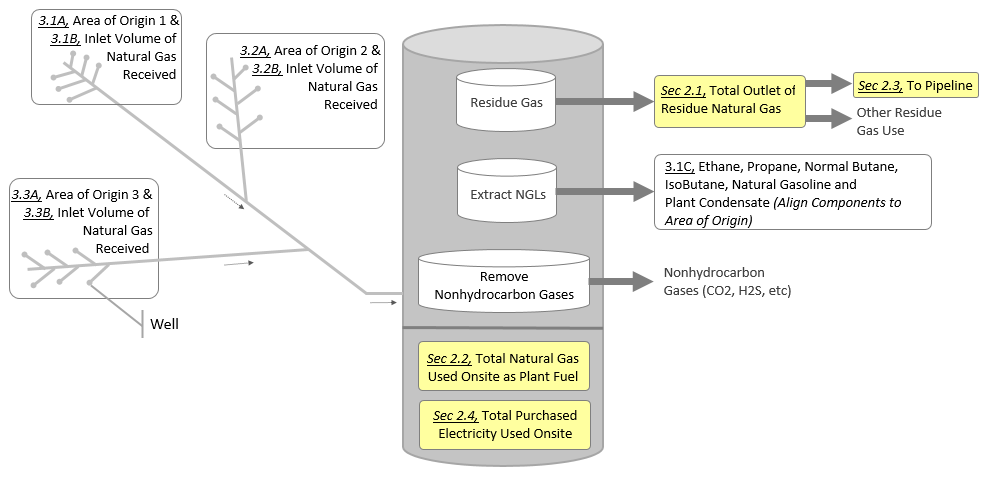 he
yellow highlighted sections in the graph below represent the natural
gas used onsite as plant fuel, residue gas, gas sent to a
transmission pipeline and electricity used at a natural gas
processing plant. Use it as a guide to answer the questions in this
section (section 2).
he
yellow highlighted sections in the graph below represent the natural
gas used onsite as plant fuel, residue gas, gas sent to a
transmission pipeline and electricity used at a natural gas
processing plant. Use it as a guide to answer the questions in this
section (section 2).
For the total residue natural gas production and process energy consumption section, report:
All annual totals for the outlet of residue natural gas, natural gas used as plant fuel, natural gas sent to pipeline, and electricity consumed at the plant.
Natural gas volumes at a pressure of 14.73 psia and 60 degrees Fahrenheit.
Natural gas volumes in million cubic feet (MMcf) rounded to the nearest million.
Electricity that is purchased and used onsite (kWH).
Zero (0) if no volumes to report.
Do NOT Report:
Any electricity generated on site.
Note:
The volume of total outlet residue gas produced may be the same as the volume sent to a pipeline.
If your company does not maintain this information, estimates may be provided. The estimating procedure and data supporting the estimates should result in reasonably accurate estimates which are subject to EIA review.
2.1. Total Outlet of Residue Natural Gas (MMCF): Report the total outlet of residue natural gas produced at the plant. Gas outlet residue production includes all natural gas produced prior to disposition.
2.2. Total Natural Gas Used on Site as Plant Fuel (MMCF): Report the volume of natural gas utilized as fuel at the natural gas processing plant. If fuel use was not metered, please provide your best estimate. If the plant utilizes some other type of fuel, such as electricity, report 0 (zero) and use the comment field in Section 2.5 to note the alternative fuel, and amount if other than electricity.
2.3. Total Residue Natural Gas Sent to Pipeline (MMCF): Report the amount of residue natural gas sent to all natural gas pipelines for transportation to market.
2.4. Total Purchased Electricity Used Onsite (kWh): Do not include any electricity generated on site.
2.5. Comments: Use the textbox to comment on any data you reported in this section (Section 2) in order to enhance clarity.
SECTION 3: ORIGIN OF NATURAL GAS AND NATURAL GAS PLANT LIQUIDS
The yellow highlighted sections in the graph below represent the inlet volumes of natural gas entering the plant and their origin, and the natural gas plant liquids extracted at a natural gas processing plant. Use it as a guide to answer the questions in this section (section 3).
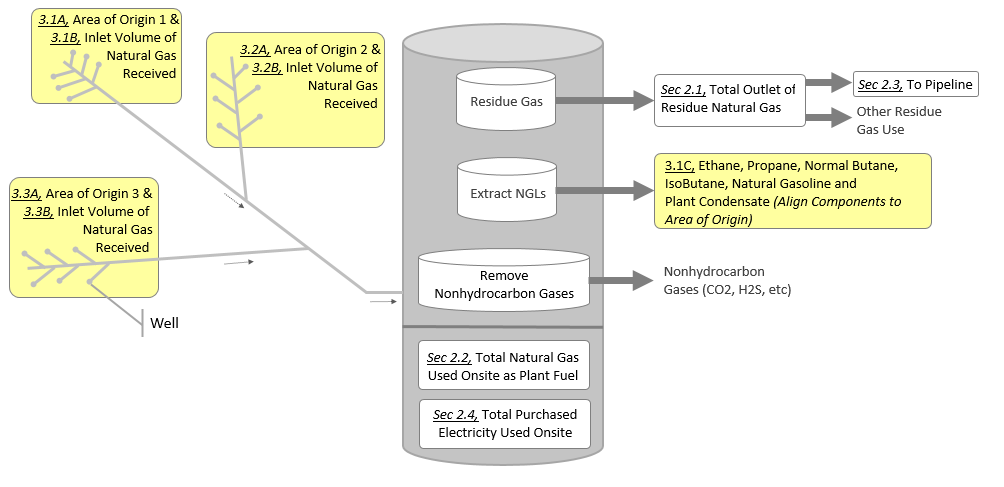
For the origin of natural gas and natural gas plant liquids section, report:
All annual totals for the inlet volumes of natural gas received, liquids extracted by product, and their area of origin.
Natural gas volumes at a pressure of 14.73 psia and 60 degrees Fahrenheit.
Natural gas volumes in million cubic feet (MMcf) rounded to the nearest million.
Natural gas plant liquids by product in thousands of barrels (mBBLs) rounded to the nearest thousand.
Zero (0) if no volumes to report.
Up to 4 areas of origins utilizing sections 3.1 – 3.4.
Do NOT Report:
Any condensate brought to the plant for stabilization nor any products created from this condensate.
Note:
If your company does not maintain this information, estimates may be provided. The estimating procedure and data supporting the estimates should result in a reasonably accurate estimate which are subject to EIA review.
3.1A. Area of Origin Code: Report the area of origin of the natural gas received for processing as specified in the list of area of origin codes and subdivision maps. The area of origin codes and maps can be found on pages 6 through 14. Contact the well operator, gas gatherer, or pipeline operator if unsure of the origin of the gas.
3.1B. Inlet Volume of Natural Gas Processed from the Area of Origin Reported in 3.1 (MMCF):
Report the volume of natural gas received for processing. These volumes are to be reported in alignment with their appropriate Area of Origin Code in Item 3.1A. Do not include refinery off gases. (See Plant Inlet in the Glossary, page 4).
3.1C. Natural Gas Liquids Extracted by Product from the Area of Origin Reported in 3.1 (mBBLS): Report the production by individual components determined by chemical analysis (i.e., ethane, propane, normal butane, iso-butane, natural gasoline, and plant condensate). These volumes are to be reported in alignment with their appropriate Area of Origin Code in Item 3.1A. Include only liquids production resulting from on-site gas processing. Include all volumes of plant condensate and scrubber oil recovered from natural gas at the plant. Do not report any condensate that was delivered to the plant by truck or isobutene that was converted from normal butane through isomerization.
If the plant received natural gas for processing from more than one area of origin, provide each additional region in subsections 3.2 through 3.4.
3.5. Comments: Use the textbox to comment on any data you reported in this section (Section 3) in order to enhance clarity.
GLOSSARY
Plant Condensate: Condensate that is heavier than natural gasoline and recovered from the inlet natural gas stream should be reported on the form. (Note: Some gas plants also process condensate in addition to natural gas. Condensate that is not part of the inlet gas stream should not be reported on the form. Any plant products (NGLs) recovered from processing the condensate stream should not be reported on the form).
Natural Gas Pipeline (Transmission Line): Residue natural gas that is sent through pipelines for consumption.
Natural Gas Plant Liquids: Those volumes of natural gas liquids recovered in natural gas processing plants.
Natural Gas Processing Plant: Facilities designed to recover natural gas liquids from a stream of natural gas that may or may not have passed through lease separators and/or field separation facilities. These facilities also control the quality of the natural gas stream to be marketed. Cycling plants are classified as natural gas processing plants.
Operating Company Name: The Company responsible for the management and day-to-day operation of one or more natural gas processing plants as of December 31 of the report year. The operator is generally a working interest owner or a company under contract to the working interest owner(s). Plants shut down during the survey year are also considered "operated" as of December 31.
Plant Fuel: Natural gas used as fuel at natural gas processing plants, including on-site fractionators.
Plant Inlet: The volume of gas that is processed at the plant. This volume may be measured upstream from the actual plant. This volume may also be called 'plant intake.'
Plant Outlet: The volume of gas that exits the gas processing plant at the outlet meter(s). This volume can also be called 'residue gas' or 'tailgate gas.'
Production, Natural Gas Liquids: Those hydrocarbons in natural gas that are separated from the gas through the processes of absorption, condensation, adsorption, refrigeration, or other methods in gas processing or cycling plants. Generally such liquids consist of ethane, propane, butane, iso-butane, and natural gasoline.
SANCTIONS
The timely submission of Form EIA-64A by those required to report is mandatory under 15 USC 772(b), as amended. Failure to respond may result in a civil penalty of not more than $10,633 each day for each violation. The government may bring a civil action to prohibit reporting violations which may result in a temporary restraining order or a preliminary or permanent injunction without bond. In such civil action, the court may also issue mandatory injunctions commanding any person to comply with these reporting requirements.
DISCLOSURE OF INFORMATION
The data reported on this form will be protected and not disclosed to the public to the extent that it satisfies the criteria for exemption under the Freedom of Information Act (FOIA), 5 U.S.C. §552, the DOE regulations, 10 C.F.R. §1004.11, implementing the FOIA, and the Trade Secrets Act, 18 U.S.C. §1905.
The Federal Energy Administration Act requires the EIA to provide company-specific data to other Federal agencies when requested for official use. The information reported on this form may also be made available, upon request, to another component of the Department of Energy (DOE); to any Committee of Congress, the Government Accountability Office, or other Federal agencies authorized by law to receive such information. A court of competent jurisdiction may obtain this information in response to an order. The information may be used for any non-statistical purposes such as administrative, regulatory, law enforcement, or adjudicatory purposes.
Disclosure limitation procedures are applied to the statistical data published from EIA-64A survey information to ensure that the risk of disclosure of identifiable information is very small.
Confidential identifiable information collected on Form EIA-64A will be provided to United States Department of Interior offices (the Bureau of Ocean Energy Management and the United States Geological Survey) for statistical purposes only, in conducting their resource estimation activities.
REPORTING BURDEN
Public reporting burden for this collection of information is estimated to average 4.0 hours per response, including time for reviewing instructions, searching existing data sources, gathering and maintaining data needed, and completing and reviewing the collection of information. Send comments regarding this burden estimate or any other aspect of this collection of information including suggestions for reducing this burden to: Energy Information Administration, Survey Development and Statistical Integration, EI-21, 1000 Independence Avenue, S.W., Washington, D.C. 20585; and to the Office of Information and Regulatory Affairs, Office of Management and Budget, Washington, D.C. 20503.
State and Federal Subdivision Codes
State Name and Geographic Subdivision1 Code
Alabama Onshore AL Alabama – State Offshore AL99 Alaska - North Onshore AKN Alaska – North State Offshore…………………… AK88 Alaska - South Onshore AKS Alaska - South State Offshore AK99 Arizona AZ Arkansas AR California – Onshore, Los Angeles Basin CA1 California – Onshore, Coastal Region CA2 California – Onshore, San Joaquin Basin CA3 California – State Offshore CA99 Colorado CO Connecticut CT Delaware DE District of Columbia DC Florida – Onshore…………………………………. FL Florida - State Offshore FL99 Georgia GA Hawaii HI Idaho ID Illinois IL Indiana IN Iowa IA Kansas KS Kentucky KY Louisiana – North (Monroe & Shreveport Districts) LAN Louisiana – South (Lafayette District) LAS Louisiana – State Offshore LA99 Maine ME Maryland MD Massachusetts MA Michigan MI Minnesota MN Mississippi – Onshore MS Mississippi – State Offshore MS99 Missouri M0 Montana MT Nebraska NE Nevada NV New Hampshire NH New Jersey NJ
|
State Name and Geographic Subdivision1 Code
New Mexico – East NME New Mexico - West NMW New York NY North Carolina NC North Dakota ND Ohio OH Oklahoma OK Oregon OR Pennsylvania PA Rhode Island RI South Carolina SC South Dakota SD Tennessee TN Texas - Railroad Commission District 1 TX1 Texas - Railroad Commission District 2 Onshore TX2 Texas - Railroad Commission District 3 Onshore TX3 Texas - Railroad Commission District 4 Onshore TX4 Texas - Railroad Commission District 5 TX5 Texas - Railroad Commission District 6 TX6 Texas - Railroad Commission District 7B TX7B Texas - Railroad Commission District 7C TX7C Texas - Railroad Commission District 8 TX8 Texas - Railroad Commission District 8A TX8A Texas - Railroad Commission District 9 TX9 Texas - Railroad Commission District 10 TX10 Texas - State Offshore TX99 Utah UT Vermont VT Virginia VA Washington WA West Virginia WV Wisconsin WI Wyoming WY Federal Offshore – Atlantic (Lower 48 East Coast)..……. FAEC Federal Offshore – Alaska Arctic (North of Bering Strait Chuckchi and Beaufort Seas) …AKAA Federal Offshore – Alaska Pacific (South of Bering Strait . Bering Sea and Pacific) ...AKPA Federal Offshore – Gulf of Mex (East Planning Area)...…. FGEP Federal Offshore – Gulf of Mex (Central Planning Area)... FGCP Federal Offshore – Gulf of Mex (West Planning Area)…. FGWP Federal Offshore – Pacific (Lower 48 West Coast)…..……FPWC
|
___________________________________
Reference maps that illustrate state and federal subdivisions and their codes for boundaries in the States of Alaska, California, Louisiana, New Mexico, Texas and the Gulf of Mexico can be found at this web link: www.eia.gov need link.
.
MAPS OF SELECTED STATE SUBDIVISIONS
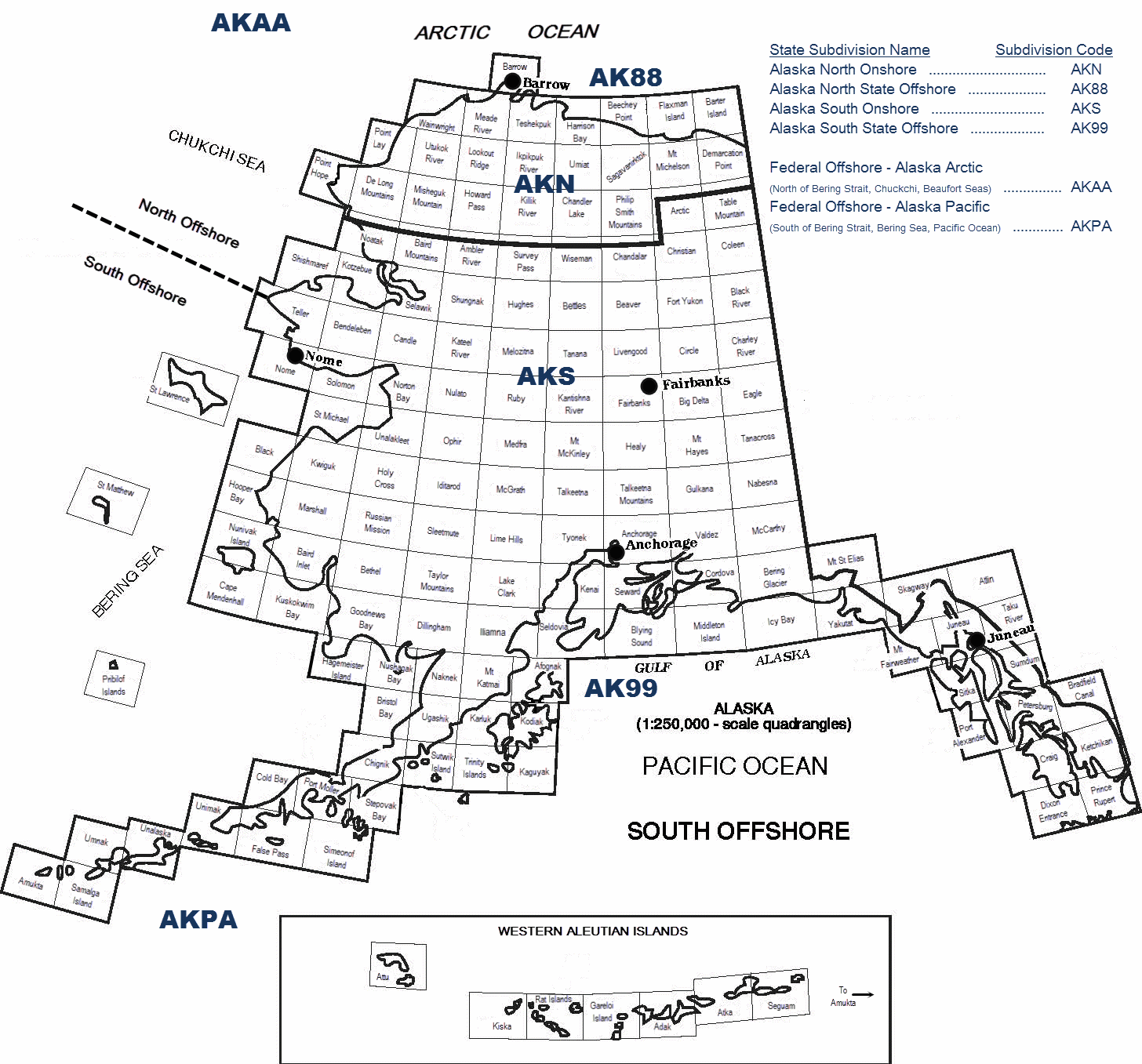
Alaska Subdivisions and U.S. Geological Report Quadrangles
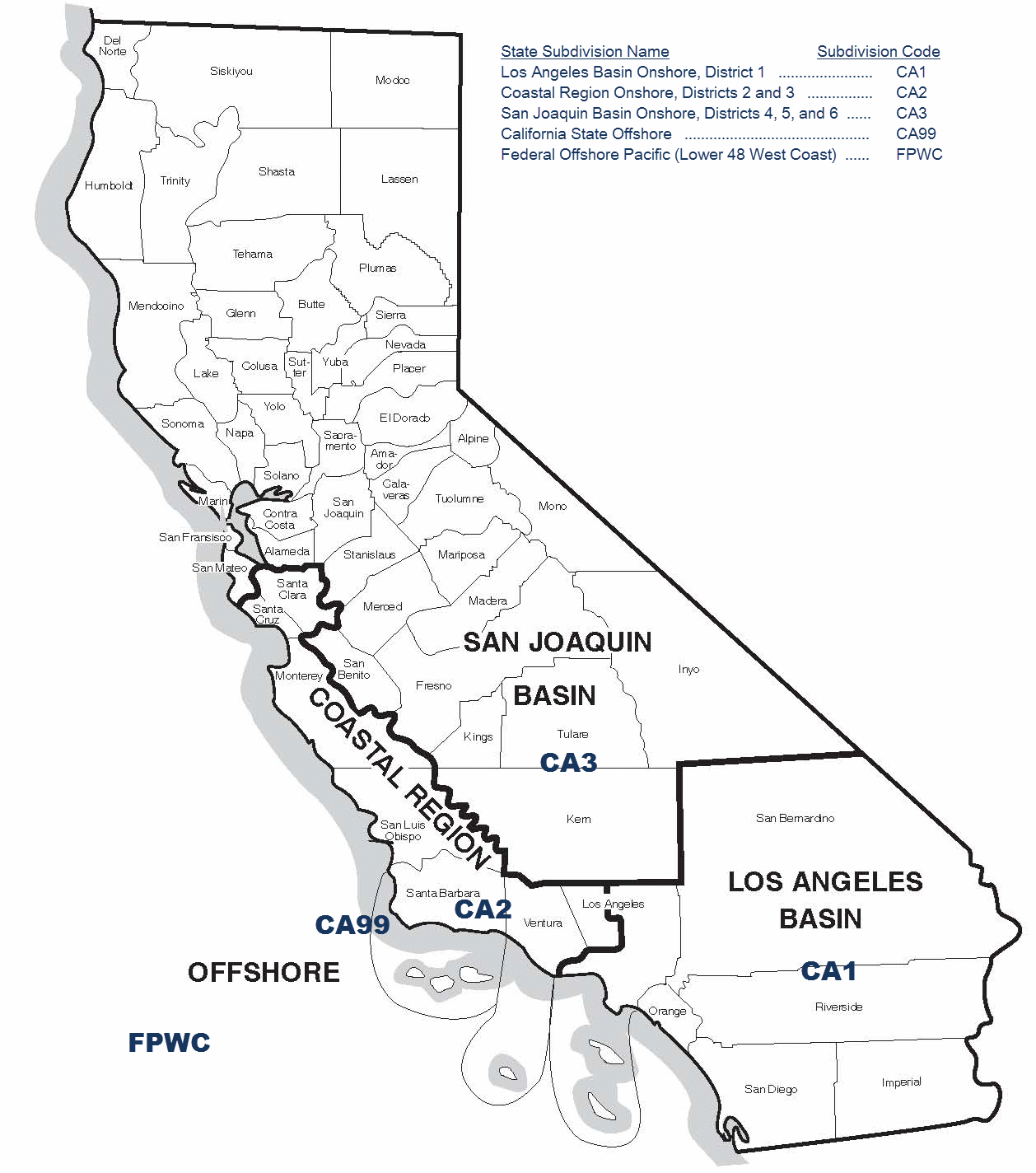
Subdivisions of California
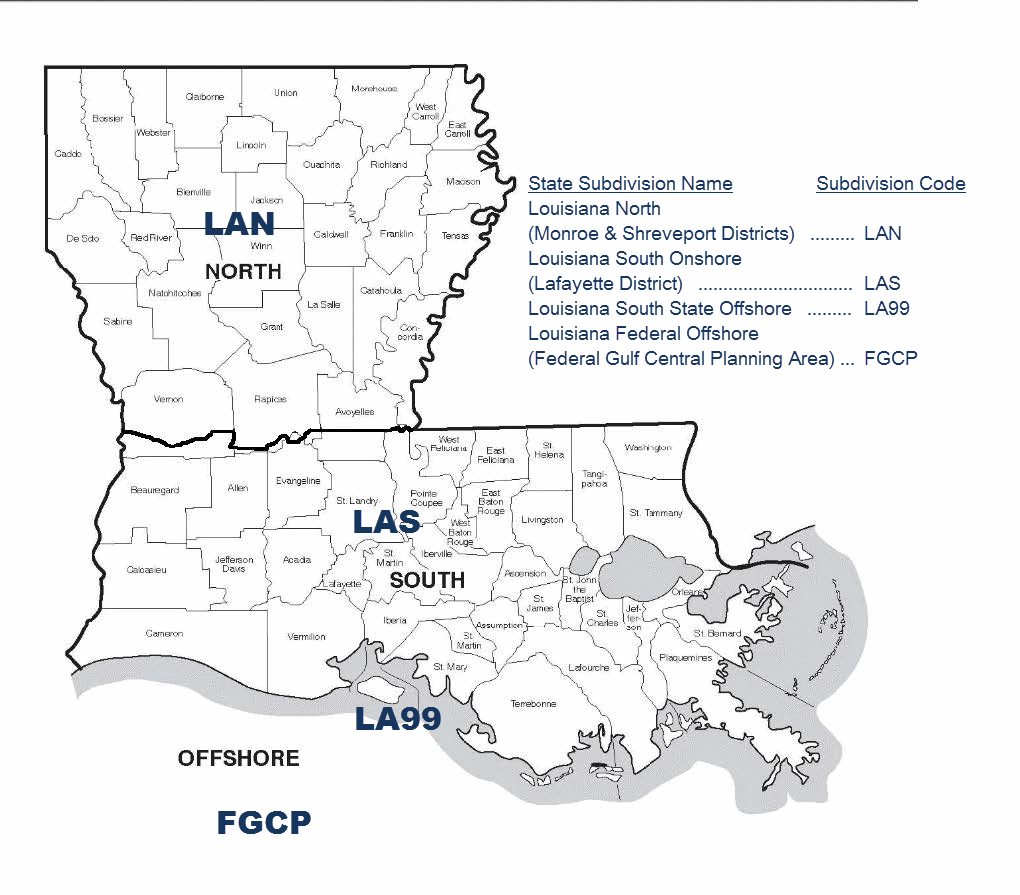
Source: U.S. Energy Information Administration, Office of Oil, Gas, and Coal Supply Statistics
Subdivisions of Louisiana

Source: U.S. Energy Information Administration, Office of Oil, Gas, and Coal Supply Statistics
Subdivisions of New Mexico
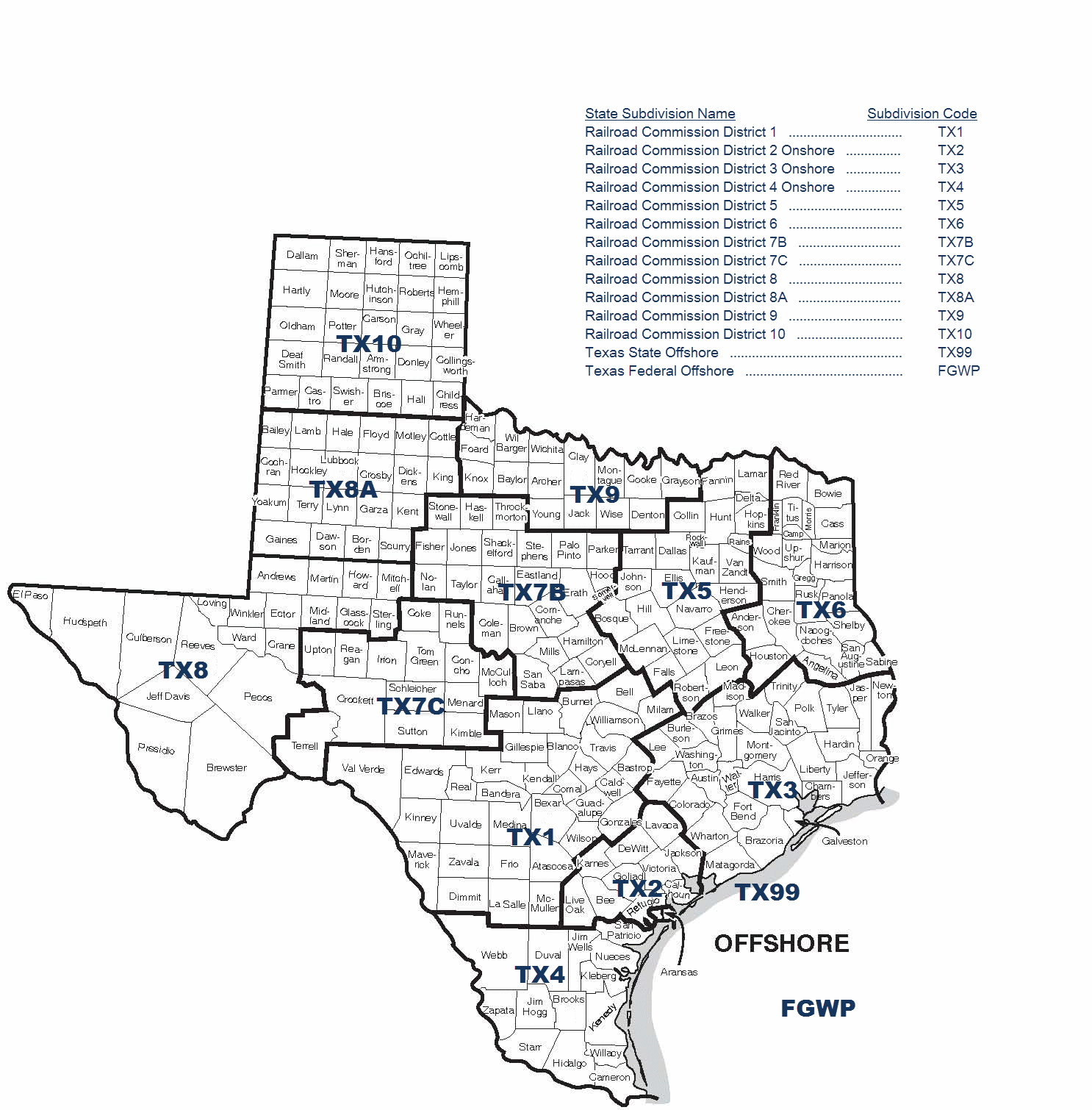
Subdivisions of Texas
Western Planning Area, Gulf of Mexico Outer Continental Shelf Region
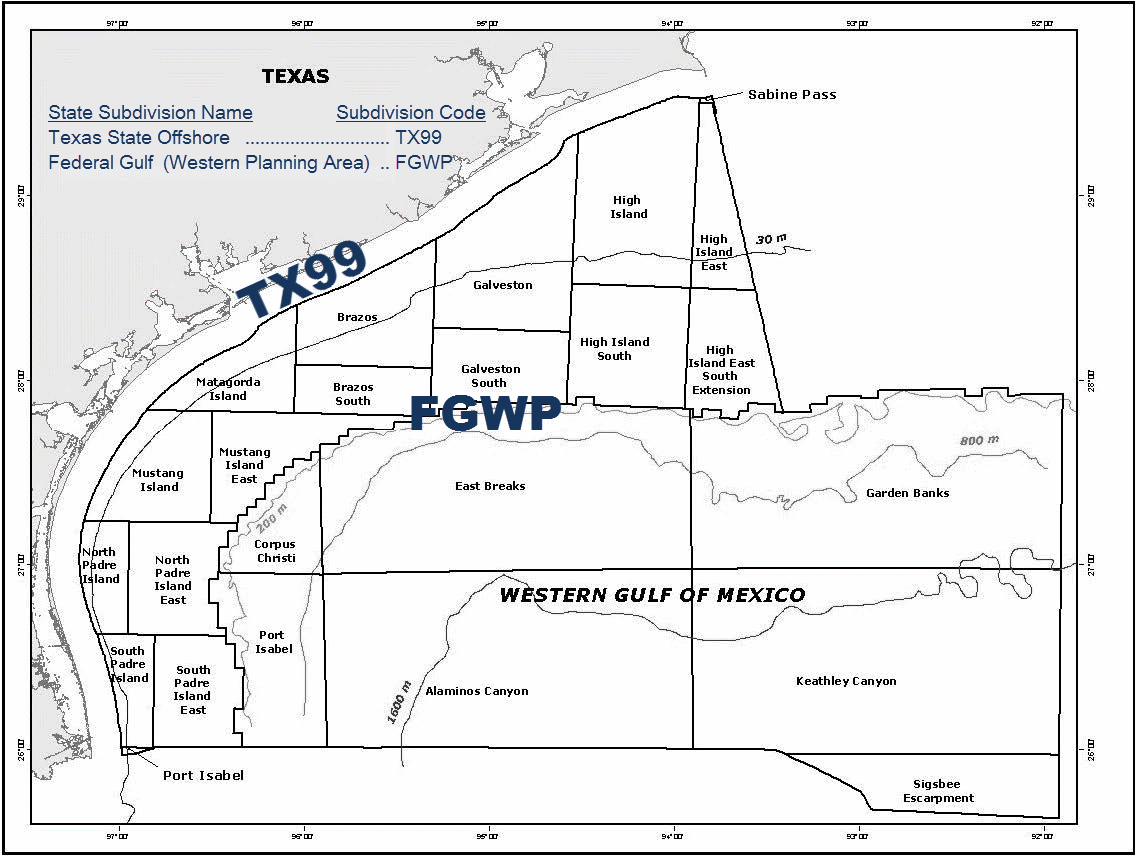
Source: U.S. Department of the Interior
Central Planning Area, Gulf of Mexico Outer Continental Shelf Region
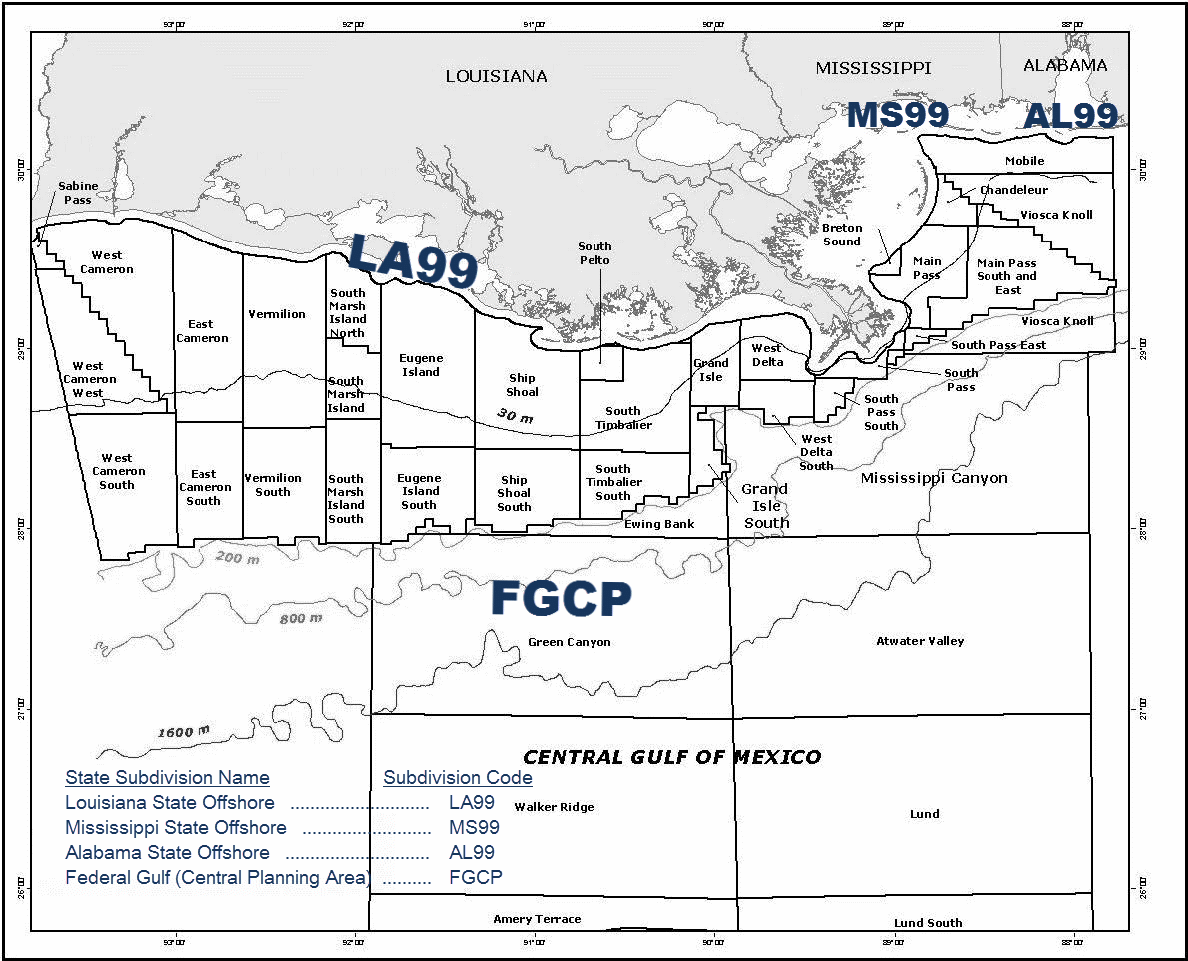
Source: U.S. Department of the Interior
Eastern Planning Area, Gulf of Mexico Outer Continental Shelf Region

Source: U.S. Department of the Interior.
2019 EIA-64A Annual Report of the Origin of Natural Gas Liquids Production
| File Type | application/vnd.openxmlformats-officedocument.wordprocessingml.document |
| File Modified | 0000-00-00 |
| File Created | 0000-00-00 |
© 2025 OMB.report | Privacy Policy